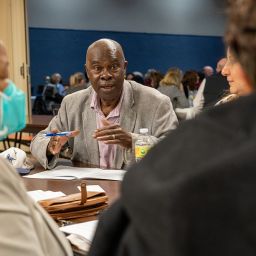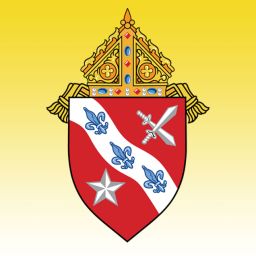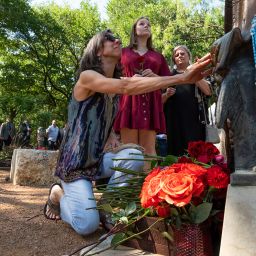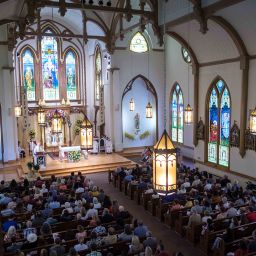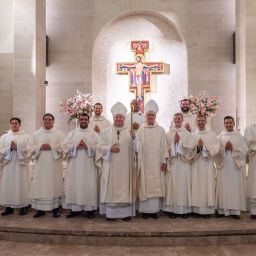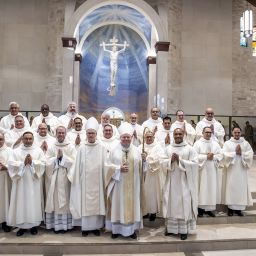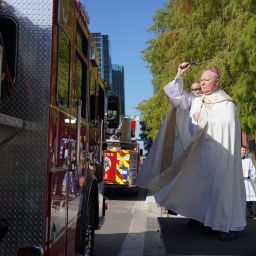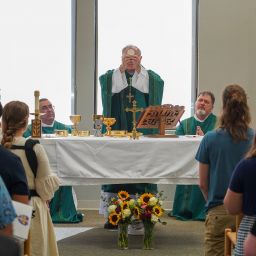
How awesome is this shrine! This is nothing but an abode of God and that is the gateway to heaven. — Genesis 28:17
The Cathedral Shrine of the Virgin of Guadalupe, located in the heart of downtown Dallas, has long been known as a landmark in the Diocese of Dallas for its enduring cultural and faith-filled significance, drawing pilgrims from across north Texas and beyond.
Now, the longtime, beloved diocesan landmark is also a national shrine.
On behalf of the Diocese of Dallas, Bishop Edward J. Burns officially announced Oct. 3 that the Cathedral Shrine of the Virgin of Guadalupe has been granted the significant designation of a national shrine by the United States Conference of Catholic Bishops.
“The Cathedral Shrine of the Virgin of Guadalupe has stood as a beacon of faith and history in Dallas for generations,” said Bishop Burns as he expressed his profound gratitude and enthusiasm for this momentous milestone. “This elevation to national shrine status is a testament to our community and parishioners’ enduring devotion, the cultural richness the cathedral embodies, and its role as a place of solace and reflection for all.
“We are immensely proud of this recognition and what it signifies. This elevation to national shrine status brings even greater dignity to our sacred space, encourages us to continue to grow and improve not only the physical plant of the cathedral, but also encourages the growth of the entire downtown neighborhood,” Bishop Burns said. “This is a tremendously positive national spotlight pointed right to our diocese and our city.”
A special Mass is planned Dec. 12 to celebrate the national shrine status of the Cathedral Shrine of the Virgin of Guadalupe, which will now be known as The National Shrine Cathedral of Our Lady of Guadalupe. It’s a designation Father Jesús Belmontes called befitting of the cathedral’s impact on Catholics within the diocese, around the nation, and throughout Central and Latin America.
“This cathedral has been a sanctuary for countless souls, a place of worship, and a center for spiritual growth,” said Father Belmontes, who serves as the cathedral’s rector. “Its architecture and history serve as an architectural analog of God’s grace as it continues the mission to serve the needs of its parishioners, the diocese, and the community at large. We are committed to continuing our service, faith, and community mission, and this recognition will inspire us to do even more for our parishioners and the city.”
The cornerstone for the cathedral was laid on June 17, 1898. Father Jeffrey A. Hartnett was pastor at the time; however, he did not live to see completion of the cathedral’s construction. Father Hartnett died serving the faithful during the 1899 smallpox epidemic, contracting the disease while attending to the spiritual needs of patients in the city’s infirmary.
On Oct. 26, 1902, Bishop Edward J. Dunne, second bishop of the Diocese of Dallas, formally dedicated the cathedral. Constructed out of red brick and limestone, and featuring many beautifully made, stained-glass windows, the cathedral was designed by architect Nicholas J. Clayton, who is regarded by many as the greatest Victorian architect Texas has ever known.
A place for pilgrims
A shrine is considered “a place where divine grace is manifested in a very special way — a place where the human and divine world intersect,” according to USCCB, which is responsible for deciding what gets the designation. To receive such a designation, several requirements must be met, including that a shrine must be dedicated “to promoting the faith of the pilgrims by centering on a mystery of the Catholic faith, a devotion based on authentic Church tradition, revelations recognized by the Church, or the lives of those in the Church’s calendar of saints.”
In Dallas, the cathedral shrine is dedicated to Our Lady of Guadalupe, the patroness of the Americas, and welcomes visitors from all walks of life to experience its beauty and spiritual solace. The Dallas cathedral has a long history of being a place of pilgrimage for Catholics, not only from the Diocese of Dallas and throughout north Texas, but especially for Catholics from Mexico and Latin America.
For many Catholics, and especially those from these regions, the feast day of Our Lady of Guadalupe on Dec. 12 holds profound significance as it commemorates the miraculous appearance of the Virgin Mary to Juan Diego in Mexico in 1531, symbolizing her maternal love and care for all humanity. The celebration of the feast day serves as a powerful reminder of faith, unity, and the enduring cultural and spiritual connection between Catholics and the Americas. As a result, tens of thousands of people make the pilgrimage to Dallas every year on Dec. 11 and 12.
“The constant flow of pilgrims to the cathedral was a fundamental element within the naming protocol,” Father Belmontes explained. “If that tradition already exists in the life of a particular temple, it is a point in favor of obtaining the designation of national shrine, and our cathedral demonstrates this.
“With this designation, the door is opened to national and international pilgrims,” the cathedral rector added.
A national shrine also must be “a center for worthy and exemplary celebrations of the liturgy, especially celebrations of the Eucharist and penance.”
“At the cathedral, we offer confessions every day because a sanctuary is more than anything a place to facilitate the encounter between the pilgrim and God and the opportunity that the pilgrim has for reconciling with God,” Father Belmontes said.
Bishop Burns agreed, noting that in addition to its regular liturgical services and cultural events, the cathedral is involved in numerous charitable and community initiatives, making it a pillar of support for those in need. The elevation to The National Shrine Cathedral of Our Lady of Guadalupe solidifies its role as a place of pilgrimage and spiritual growth across the country.
“We continue to look forward to the future,” Bishop Burns said. “This means our work continues to preserve and enhance this cherished landmark’s historical and spiritual significance.”



